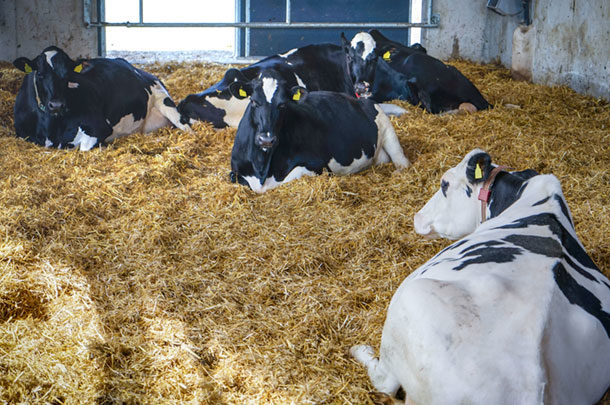A basic understanding of why core-antigen vaccines are an effective tool during the dry period can help clear up common myths surrounding their usage.
More than 50% of clinical coliform mastitis events that occur in the first 100 days in milk originate during the dry period. A core-antigen vaccine helps a dairy cow’s immune system recognize a coliform, such as Escherichia coli (E. coli), when it invades the udder (quarter), triggering an immune response.
Here are common myths and the truth about core-antigen vaccines.
Myth 1: Core-antigen vaccines prevent infection.
Core-antigen vaccines will not stop new E. coli intramammary infections (IMIs); they reduce the severity of these infections. When administered properly, successful immunization can reduce mastitis severity, milk loss, culling and death associated with E. coli infections.
Cows vaccinated with a gram-negative core-antigen vaccine respond with an enhanced immunologic response to coliform bacteria entering the mammary gland. This response is due to vaccine-induced antibodies coating the bacteria, allowing for increased removal by white blood cells. This hinders the bacteria from replicating and becoming a more severe infection. A reduction in bacterial numbers results in reduced udder bacterial invasion and damage. Additionally, less bacterial endotoxin is released into the bloodstream, leading to less-severe systemic signs in the cow.
Myth 2: Core-antigen vaccines offer protection against all types of mastitis.
Commonly, mastitis bacteria are classified as either gram-positive or gram-negative. The difference is in the structure of the outer bacterial cell wall. Core-antigen vaccines are used to trigger an immune response to E. coli, which is gram-negative. Therefore, these vaccines have no effect on mastitis caused by staphylococci, streptococci or other gram-positive bacteria.
A typical herd-level milk culture profile will show one-third of isolates are coliform bacteria, one-third are gram-positive bacteria and another third are no-growth, of which many are classified as self-curing coliform infections. Naturally, this profile varies by farm and time of year, but it serves as a reminder of the importance of the purpose of this class of vaccines.
Clinical mastitis cases caused by gram-negative pathogens are common during the early stages of lactation. Because of increased risks from calving to 90 days in milk, cows and first-lactation heifers can benefit from proper administration of a core-antigen vaccine protocol.
Myth 3: Core-antigen vaccines offer the best protection when given at dry-off and at calving.
The lapse of time between dry-off and calving is too great for animals to adequately respond to a core-antigen vaccine. Protective antibody production is not maximized, which leads to ineffective antibody levels in the blood. Antibody blood concentrations can return to pre-vaccination levels within a couple of months after the last immunization, so timing is critical.
For maximum protection, it is important to administer an initial dose of a core-antigen vaccine at each dry-off to prime the immune system. Properly timed follow-up dosing intervals build up immunity levels against coliform bacteria. Three doses are recommended at four- and six-week intervals. A third dose given after calving helps sustain a cow’s antibody levels into the first months of lactation, when she is more susceptible to coliform mastitis. Always follow label instructions, and do not vaccinate within two weeks prior to calving.
Myth 4: Coliform mastitis vaccines work in any situation.
Manure is a major source of coliform bacteria, and the bacteria flourishes in the cow’s environment. Regularly providing clean, dry bedding and clean, fresh water sources helps cows reap the full benefit of a core-antigen vaccine.
Providing adequate bunk and resting space for cows can also minimize the spread of bacteria. Particular attention should be given to the maternity pen by assuring proper sanitation and hygiene protocols.
Don’t forget about the importance of animal handling, as stressors in the cow’s environment can impact her immune response. Manage temperature extremes (i.e., heat stress), and keep cows calm to improve their response to core-antigen vaccines.
A cow’s exposure to coliform bacteria can occur 24 hours a day, seven days a week. Combining sound management practices with proper use of core-antigen vaccines helps achieve success against environmental coliform pathogens.
Myth 5: Cows with clinical mastitis, regardless of the cause, will benefit from vaccination with a core-antigen vaccine.
Core-antigen vaccines are not a treatment; they aid in a cow’s ability to prevent IMIs from becoming severe. Research shows core-antigen vaccines decrease the incidence and severity of clinical coliform mastitis (CCM) cases and should not be used to treat gram-positive infections. Proper use of core-antigen vaccination to help prevent IMIs can have a tremendous positive impact on milk quality and udder health in the ensuing lactation.
Myth 6: Core-antigen vaccines should not be administered in conjunction with other vaccines.
No more than two gram-negative vaccines should be given at one time to avoid potential adverse endotoxin effects, which can include fever, lack of appetite, depression, shock, abortion and even death. Not all core-antigen vaccines are created equally; look for a vaccine that has its endotoxin level printed on the bottle for confident product use and safety in your herd.
Work with your veterinarian, and always follow label directions for handling, storing and administering vaccines. Never use an out-of-date core-antigen vaccine or shake the bottle too vigorously, as this can increase the level of endotoxin in the vaccine.
—Article used with permission from Merck Animal Health.






